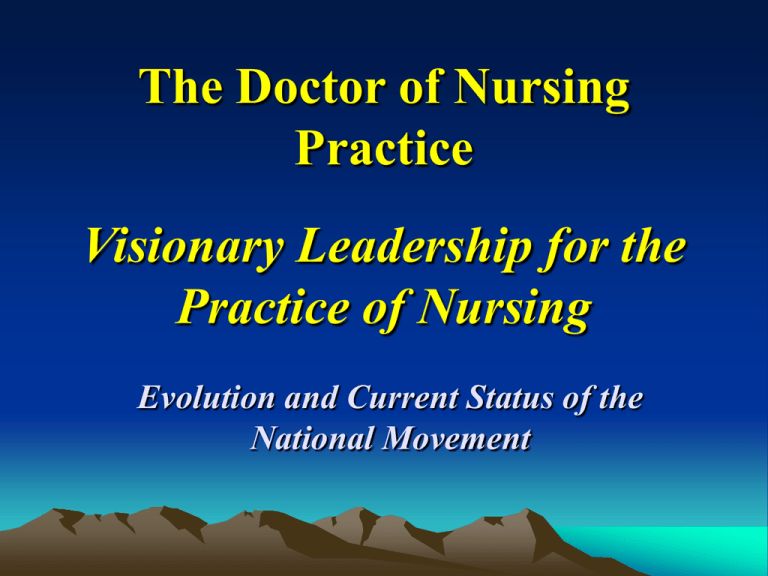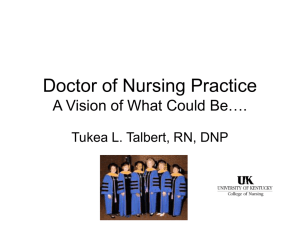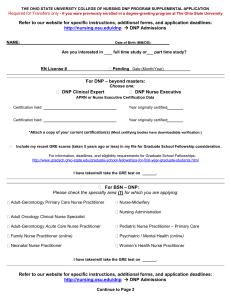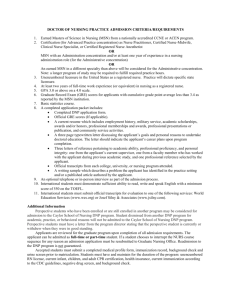Visionary Leadership for the Practice of Nursing
advertisement

The Doctor of Nursing Practice Visionary Leadership for the Practice of Nursing Evolution and Current Status of the National Movement Overview of Presentation • Introductory Comments on the Present Context and the Development of the DNP • Discussion Related to the Work of the Road Map Task Force • Description of the Work of the Essentials Task Force Focus of Comments Related to the Road Map Task Force • Comment on the Paradigm Shift Occurring in Graduate Education in Nursing • Describe the Task Force’s Charge • Comment on Diffusion of Innovations as a Framework for Looking at what is happening and a Framework for Guiding the Work • Discuss Frequently Asked Questions and Fears • Comment on Feedback from Regional Conferences It is About the FUTURE !!! Creating the Future We have a responsibility to create the future for our patients, for our profession, and for the health of the public. A Paradigm Shift is Underway in Graduate Education in Nursing • A Number of Factors are Converging to Build Momentum for a Major set of Shifts • These Include: Aging of the Population; Expansion of Knowledge Underlying Practice; Increased Complexity of Patient Care; Major Concerns about Quality of Care and Patient Safety; Shortages of Nursing Personnel Demanding a Higher Level of Preparation for Leaders Who Can Design and Assess Care and Lead; Shortages of Prepared Nursing Faculty, Leaders in Practice, and Nurse Researchers, and Increasing Educational Expectations for the Preparation of other Health Professionals Position Statement on the Practice Doctorate in Nursing October 2004 National Academy of Sciences 2005 Report on Nursing Research • The Report Focuses on Increasing the Number of Nurse Scientists and Increasing the Number of Productive Research Years for Nurses Prepared in PhD Programs National Academy of Sciences 2005 Report • Calls for a distinction between • “the educational needs and goals of nursing as a practice profession that require practitioners with clinical expertise from • Nursing as an academic discipline and science that requires independent researchers and scientists to build the body of knowledge” (p.74) National Academy of Sciences 2005 Report • “The need for doctorally prepared practitioners and clinical faculty would be met if nursing could develop a new nonresearch clinical doctorate, similar to the M.D. and Pharm.D. in medicine and pharmacy, respectively.” Development of the Clinical Nurse Leader at the Master’s Level Graduate Education in Nursing 2004 Graduate Education in Nursing 2004 - 2010 Members of the Roadmap Task Force • • • • • • • • • Kathleen Andreoli – Rush University Debra Davis – University of South Alabama Carolina Huerta – Univ. of Texas-Pan American Martha Hill – Johns Hopkins University Nancy Mosser – Waynesburg College Robyn Nelson, Cal. State Univ.-Sacramento Marjorie Lawson – Univ. of Southern Maine Anna Alt-White – Dept. Veterans Affairs, D.C Carolyn Williams (Chair) Univ. of Kentucky Charge of the Roadmap Task Force • Develop an Implementation Plan that provides a Roadmap for Achieving the Goals of the Position Statement by 2015 • Delineate Key Institutional and Academic Issues that Must be Addressed in Academic Institutions Charge of the Roadmap Task Force • Assess Regulatory and/or Legislative Frameworks that Shape Practice Authority, Reimbursement, and/or Academic Authority, and Identify Implications of these Frameworks and • Identify Actual and/or Potential Challenges and Opportunities Inherent in the Assessments and Make Recommendations Charge of the RoadmapTask Force • Map Potential Interfaces and/or Partnerships that can be Created to Assist Undergraduate and Graduate Nursing Programs to Participate in Achieving the 2015 Goal • Develop Recommendations that Detail Actions and Timelines for Accomplishment with Specific Focus on the Role of AACN in Facilitating the Implementation Process Rogers ’Diffusion of Innovations as a Conceptual Framework • A Way of Looking at What is Happening • A Framework for Guiding Our Work Diffusion of Innovations • Provides a Conceptual Framework for Understanding the Process of the Adoption of New Technologies or Practices and Social Change • An Innovation is an idea, practice, or object, that is perceived as new • The diffusion component is the process by which an innovation is communicated Diffusion of Innovations • Generally an innovation moves slowly through a group when it is first introduced. Many are skeptical and resist change, but as the number trying the innovation increases the idea moves at a faster rate especially if the early adopters are pacesetters • The diffusion phenomenon initially follows an S-shaped curve Variables Determining the Rate of Adoption – Attributes of the Innovation • Relative Advantage - Better than Previous Approaches • Compatibility – Consistent with values/needs • Complexity – Degree to which it is difficult to Understand or put into place Varibles Determining Adoption – Attributes of the Innovation • Triability – The degree to which an innovation can be experimented with • Observability – The degree to which the results of an innovation are visible to others Variables Influencing Rate of Adoption • Communication Networks and Opinion Leaders • Extent of Change Agent Efforts/Effectiveness – key elements include developing contact with “clients”, developing a felt need for change, providing information exchange – effectiveness is increased if there is similarity between the change agents and those they are seeking to influence Reference on Roger’s Work Rogers, E.M., (2003). Diffusion of Innovations. New York, Free Press. Work of the Task Force • We Understand that our Job is NOT limited to data gathering and getting out a Report - BUT A REPORT WE WILL DO!!! • We need to Establish Mechanisms for Input from Various Stakeholders • We need to serve as Change Agents and Encourage Others to Do So Work of the Task Force • Development of Communication Opportunities in Various Media • Regional Conferences in Partnership With Essentials Task Force • National Nursing Stakeholders Meeting in Partnership With Essentials Task Force • Participation in Conference Calls with Various Organizations Work of the Task Force • As we Think Things Through we also Need to Provide Information About the Innovation and Opportunities to Help the Community of Potential Adopters and other Stakeholders Clarify Their Understanding of the Innovation and Reduce Uncertainty • This Translates Into Developing Materials and Developing Communication Channels such as Conferences and The Internet Figure I INFORMATION AND “VIEW” GRID Information HIGH Let’s get on with it! Stamp this out! LOW Products in Process • • • • Frequently Asked Questions – On Web Bibliography on the DNP – On Web Pathways Diagram – On Web Comparison of DNP and PhD/DNSc/DNS Programs – Done with Essentials T. Force • Strategy For Growing DNP Faculty • Description of An Institutional Partnering Effort • Possibility of a DNP “Tool Box” ISSUES IDENTIFIED AT THE FOUR REGIONAL CONFERENCES, AT THE NATIONAL STAKEHOLDER’S CONFERENCE, AND AT AACN’S FALL MEETING Faculty • Development of Faculty for DNP Programs • Preparation of Preceptors • Credentials Required to Teach in a DNP Program • The Extent to which Engagement in an Active Practice is Needed • Definitions of Scholarship • Tenure Possibilities for DNP Faculty Program Questions • Could Students be Certified before completing the DNP so they could “Practice” at some level? • Should Program Models provide for a Jump-out at some point (MSN ? ) to allow for Practice and then Continue to DNP? • Need for Multiple Pathways • Strategies for Maintaining Quality and Rigor Institutional Issues • Possible Impact on Non-Doctoral Institutions • Possible Effect on an Institution’s Carnegie Classification • Possibilities for Collaboration Among Various Institutions • Strategies for Making the Case to the Institution • Distance Learning Partnerships for Rural Areas Costs/Funding • Costs for Students and Return on Investment • Availability of Financial Aid for DNP Students, including Assistantships • Possibility of National Funding for Paid Residencies • Possibilities for HRSA Funding • Costs for Institutions • Reimbursement Issues Market Issues • Strategies for Marketing to Students, including those in Rural Areas • Strategies for Informing the Public, Physicians, and Other Professional Groups • Nature and Extent of the Market for Graduates - In the Practice Arena and Marketability of DNP Grads to Universities • Strategies for Countering Misinformation Master’s Programs • Impact on Current Master’s Programs • What Type of Master’s Programs will Continue? • Will CCNE Continue to Accredit Master’s Programs? Licensure and Certification • Practice Acts May Vary and There May need to be some Changes in Some States • Clarification of the Future Certification Status for Those Currently Certified who do not obtain a DNP • Possible Usefulness of a National Definition of Advanced Practice Political Issues • Extent of Support for Transition from State Regulatory and Educational Bodies • Impact on Rural Areas • Extent to Which the DNP will Change the Expected Supply and Demand for Nurses Prepared at the Master’s and Doctoral Levels • Impact of Retirements on Reaching 2015 Goal • Options for Programs Not Housed in a School of Nursing • Use of Title “Doctor” Evaluation • • • • • • NEED DATA ON : Sustainability of Programs Graduates Value Added Career Mobility Practice Patterns Frequently Asked Questions Is this program just for primary care providers? No, the DNP degree prepares individuals for a variety of roles at the highest level of nursing practice Are there going to be standards for programs? Yes, the DNP Essentials document will help guide development of standards. CCNE has indicated the intent to establish accreditation standards. Is there going to be credentialing for individuals? Yes, individuals will continue to be credentialed by the various specialty organizations. Frequently Asked Questions Does the DNP prepare for faculty positions? As a professional doctorate, DNP curricula focus on the core discipline of nursing, teaching content could be incorporated in addition to this core. Will all APN’s have to get a DNP? Current APN’s will retain their privileges, after 2015 all APN programs should be offered through DNP programs. Frequently Asked Questions Will faculty with DNP be eligible for tenure? Tenure is an institutional prerogative with two major considerations. 1. Who is eligible for tenure? If the institution tenures holders of other professional degrees (EdD, MD, PsyD, PharmD, JD, PTD, AudD, etc.) then DNP graduates should also be tenurable. 2. What are the criteria for tenure? If the institution defines scholarly productivity broadly to include external funding and publications other than that associated with only NIH R-Level grants, then the DNP graduate should be tenurable. As a Profession, should we let current tenure policies in some universities determine what is needed in Nursing Practice, OR should we find ways to help universities develop policies that support the education of nurses for the FUTURE??? Frequently Expressed Fears There are no data to support these programs. The Aiken data suggest that health outcomes improve as the educational level of nurses increases Surveys of graduates indicate they have acquired new knowledge and skills that have enhanced their practices Reports from employers are indicating DNP graduate are bringing added valued to their places of employment Frequently Expressed Fears PhD Program enrollments will decline. There is no evidence for this. Those who select the DNP appear to be from a population that is not interested in a PhD and probably would not engage in doctoral study without the emergence of the practice doctorate. 1997 1998 1999 2000 2001 2002 2003 2004 2005 Univ. Tenn. Memphis PhD 14 18 16 18 19 19 19 18 28 Univ. Ky DNP 13 41 38 42 44 52 62 PhD 32 33 38 36 38 44 50 55 52 DNP 13 26 29 32 30 Doctoral Students at University of Tennessee - Memphis 70 60 50 40 PhD DNP 30 20 10 0 1997 1998 1999 2000 2001 2002 2003 2004 2005 Doctoral Students at the University of Kentucky 60 50 40 PhD DNP 30 20 10 0 1997 1998 1999 2000 2001 2002 2003 2004 2005 FOR THE PROFESSION OF NURSING IT IS NOT THE PhD OR DNP, IT IS BOTH !!! For the Individual, it may be one or the other, or for a few, it could be both. What Kind of Individuals are Attracted to the DNP? “I have been waiting for a program like this, I am not interested in a research career, but there is more I need to learn to make me a better practitioner.” Doctoral Education for Nursing Practice 1960—Boston University opens 1st clinical doctorate 1979—Case Western Reserve opens 1st ND program 1999—UTHSC opens DNSc practice doctorate 2001—University of Kentucky opens First DNP Program 2002—AACN forms practice doctorate Task Force 2003—Columbia University admits students 2004—AACN members approve DNP Position Paper 2005—(Spring) 8 programs admitting students, 60 schools considering programs 2005—(Summer) 80 schools considering programs 2005—(Fall) 20 programs “approved” An Important Driver is the Growing Desire Clinically Focused Nurses Have in Advanced Study that will Enhance their Effectiveness Are we at a Tipping Point? Factors Contributing to the Tipping Point IOM called attention to problems facing health care 1999—To Err is Human, focused on fragmented nature of health care 2001—Crossing the Quality Chasm, calls for a restructuring of healthcare 2003—Health Professions Education: A Bridge to Quality call for educators to prepare health care providers for a new type of practice as members of interdisciplinary teams that emphasize evidencebased practice, quality improvement, and informatics Factors Contributing to the Tipping Point Expanding length of MSN programs • longer than most masters (many 60+ hrs and 3 yrs) • didactic and clinical increased by 72 and 36 hours respectively for NP programs between 1995-2000 (AACN & NONPF 2002) • even more content is needed (eg., information and practice management, health policy, risk management, evaluation of evidence, and advanced diagnosis and management) (Bellack, Graber, O’Neil, Musham, & Lancaster, 1999; Lenz, Mundinger, Hopkins, Clark, & Lin, 2002). Factors Contributing to the Tipping Point Movement of other disciplines to the doctorate (MD, DDS, PsyD, DPT, PharmD, AudD) Emerging and active interdisciplinary teams “The tipping point for me was when I was at a team meeting and everyone there had a doctorate in their respective fields except the nurse.” The Mission Becomes Apparent “Nurses prepared at the doctoral level with a blend of clinical, organizational, economic and leadership skills are most likely to be able to critique nursing and other clinical scientific findings and design programs of care delivery that are locally acceptable, economically feasible, and which significantly impact health care outcomes.” AACN Position Paper on the Practice Doctorate Where Does that Put Us Today? “There exists a fleeting and deliriously exciting moment in the life of an idea when it teeters between what one person suspects and what everyone accepts. In that moment, months or years before it exerts any practical influence, the idea holds the greatest potential to inspire and incite. Opportunities, implications, and related discoveries open up from it in all directions like a hall of mirrors.” (Harvard Business Review, February 2005. Introduction to the years “Best Innovations”) Essentials Task Force Members Janet Allan – University of Maryland Julie Sebastian – University of Kentucky Edward Thompson – University of Iowa Maureen Keefe – University of Utah Ann Hamric – University of Virginia Judy Honig – Columbia University Carol Howe - Oregon Health and Science University Elizabeth Lenz – The Ohio State University Heidi Taylor - West Texas A & M University Sr. Mary Margaret Mooney – North Dakota State University The Essentials of the Doctorate of Nursing Practice Task Force charged to develop the curricular and content requirements for the DNP as well as identify the competencies to be acquired in a DNP program. The document follows the model of the BSN and Masters Essentials Provides direction for program development and accreditation. Charge to Task Force Develop the curricular and content requirements for the DNP as well as identify the competencies to be acquired in a DNP program Establish a clear strategy for educational changes and transition, and hallmarks that distinguish the DNP from existing programs that offer the Master of Science in Nursing Identify the critical curricular content that should be present and competencies that should be acquired in the DNP programs in which master’s prepared nurses seek to acquire the DNP Develop recommendations and strategies for AACN, and the full contingent of AACN’s academic programs to respond to this transition. Essentials Reflect Competencies for All Graduates BS (nursing) BS (non-nursing) DNP MS-APN MS-non-APN Task Force Strategy Re-confirm 7 essentials identified by original Practice Doctoral Task Force Read a lot, and consult constituents and leaders Discuss and deliberate—8th essential added “Clinical Prevention and Population Health for Improving the nation’s Health” Draft document core—the essential competencies and related curricular content Hold regional and stakeholder meeting for feedback Post draft document on web site for feedback Preliminary Content for the Essentials Introduction Background/Trends leading to this paradigm shift Summary of process and purpose of the document Context of Graduate Education in Nursing Relationship of MSN, DNP, and PhD Integration of faculty/teaching role in graduate nursing education Doctoral Education for nursing practice Broad curricular model—includes links to specialty certifying bodies Description of 8 Essentials (document circulated at regionals) Curricular Elements (content circulated at regionals) DNP Programs in the Academic Environment Curricular parameters (eg, typical length/credit hours) Residency Capstone Project Faculty characteristics Glossary Format of Section of the DNP Essential Draft Currently Under Review Not the complete document or final format—only a section Introduction Review of 2004 TF recommendations Summary of Process Task Force creation Regional meetings Definition of advanced nursing practice Curriculum Model Essential Competencies Overview of the Curriculum Model DNP is a degree preparing individuals for multiple roles. Seven of the core competencies are for all graduates regardless of role. Core competencies form the basic foundation for advanced nursing practice (essential 8) where competencies bifurcate with the DNP program of study focusing on either: Roles involving the direct delivery of care to individuals, families, and/or populations Roles that influence the delivery of care indirectly through organizational and system leadership. Linkage of DNP Curriculum Model to Specialty Practice Specialty specific competency expectations continue to be defined by specialty groups such as NP, administration, CNS, or other specialty practice areas 7 Foundational Core Essential Competencies Advanced Nursing Practice Core Essential Competencies Direct Care Competencies OR Systems/Organization Competencies Specialty Practice Competency Expectations Overview of the Competency Section Each of the Eight Essentials includes: • Background information which provides the rationale for the essential nature of each competency for the highest level of nursing practice. • A statement regarding the specific competencies for each DNP essential. Includes integration of masters level competencies while adding competencies that reflect the highest level of nursing practice • Recommended content for each essential Recommended DNP Content Some content overlaps or is noted multiple times due to the synergistic nature of competencies and the utility of some content for more than one essential. Content ≠ Course Essential Competencies for DNP Graduates 1. Scientific underpinnings for practice Recognizes the philosophical and scientific underpinnings essential for the complexity of nursing practice at the doctoral level. 2. Organizational and systems leadership for quality improvement and system thinking Recognizes the competencies essential for improving and sustaining clinical care and health outcomes, eliminating health disparities, and promoting patient safety and excellence in care. Essential Competencies for DNP Graduates 3. Clinical scholarship and analytical methods for evidence-based practice Recognizes competencies essential for translation of research into practice, evaluation of practice, practice improvement, and the development and utilization of evidence-based practice. 4. Technology and information for the improvement and transformation of patient-centered health care Recognizes competencies essential to manage, evaluate, and utilize information and technology to support and improve patient care and systems. Essential Competencies for DNP Graduates 5. Health care policy for advocacy in health care Recognizes the responsibility nurses practicing at the highest level have to influence safety, quality, and efficacy of care, and the essential competencies required to fulfill this responsibility. 6. Interprofessional collaboration for improving patient and population health outcomes Recognizes the critical role collaborative teams play in today’s complex health care systems and the competencies essential for doctorally prepared nurses to play a central role on these teams. Essential Competencies for DNP Graduates 7. Clinical prevention and population health for improving the nation’s health Added to original competencies in response to: • IOM 2001 call for transformation “…of health professional education in response to the changing needs of the population and the demands of practice.” • Health People 2010 support of IOM and objective to include “core competencies in health promotion and disease prevention” in clinical education • In consideration of nursing’s the longstanding focus on health promotion and prevention Essential Competencies for DNP Graduates 8. Advanced nursing practice for improving the delivery of patient care Recognizes the essential competencies reflective of the distinct, in-depth knowledge and skills that form the basis for nursing practice at the highest level regardless of practice role. Essential Competencies for DNP Graduates 8a. APN or individual and population-focused competencies for the DNP graduate Recognizes the unique competencies associated with the specialized knowledge and clinical expertise essential for the direct care of individuals, families, or discrete population aggregates. 8b. Systems or organization-focused competencies for the DNP graduate Recognizes the unique competencies associated with the organizational expertise and specialized knowledge essential for leadership of health care delivery systems. Scheduled Constituent Meetings Boston Regional—September 14-15 76 attendees from 45 institutions St. Louis Regional—September 29-30 116 attendees from 56 institutions Washington Stakeholder—October 11 Atlanta Regional—November 3-4 Houston Regional—December 8-9 San Diego Regional—January 12-13 Regional Process Gather input and as clear, consistent messages emerge they will be incorporated Iterative process with changes made between regional meetings and posted on web site Less clear or consistent suggestions tracked and reviewed for incorporation following completion of regional meetings Final changes made and draft completed for submission to AACN Board by summer 2006 Final draft to membership October 2006 Feedback to Date The eight essentials are being affirmed Minor changes and suggestions for wording and format Need to address teaching expectations for DNP graduates Support for duality of advanced nursing practice roles (direct care delivery and organizationalsystems leadership) Desire to control length of program is being expressed Need further clarification of masters and DNP relationship Feedback to Date Need direction regarding residency and capstone project Redundancy in content across essentials, need to clarify that some content has relevance for multiple competencies. Clarify that content does not equal course. Some outcome competencies and content is more reflective of the masters level, need to clarify that the masters essentials have been integrated along with the addition of a higher level of practice competencies.





